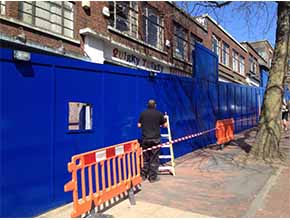Protecting the Public from Your Construction Site
 Public liability is one of those phrases which literally sums it up for your company: you have a responsibility to protect the public from your construction site and will be liable in the event that a member of the public (or indeed those working with you and for you) are put at risk or affected by issues relating to your work, including your site. Building contractors can be prosecuted and find themselves liable for substantial fines, such as the £20,000 a Worcestershire-based contractor was fined in 2014 after a female passer-by sustained significant injuries from hoardings which were blown free from a construction site during high winds (source: The Construction Index). So when lives of the public, as much as profits and reputation of your business are at stake, how should you go about protecting the public from your construction site?
Public liability is one of those phrases which literally sums it up for your company: you have a responsibility to protect the public from your construction site and will be liable in the event that a member of the public (or indeed those working with you and for you) are put at risk or affected by issues relating to your work, including your site. Building contractors can be prosecuted and find themselves liable for substantial fines, such as the £20,000 a Worcestershire-based contractor was fined in 2014 after a female passer-by sustained significant injuries from hoardings which were blown free from a construction site during high winds (source: The Construction Index). So when lives of the public, as much as profits and reputation of your business are at stake, how should you go about protecting the public from your construction site?
Perimeter and prevention
The first thing to consider is keeping your sites (and therefore the public) secure. This includes having clarity over:
- The exact boundaries of your site
- How your site should be secured for maximum risk-limitation
- The use of adjacent land, in particular any shared boundaries
- Access to the site, including shared access with other sites or public areas (such as in the case of a public pavement or right of way).
After considering these aspects, a risk assessment (and therefore risk-reduction action) can be designated across three key areas:
1) Site access management
2) Site specific hazards which put the public at risk
3) Considering vulnerable groups
1) Site access management
Having identified the site boundaries, through plans and site surveys, the boundaries will need to be physically defined using appropriate security fencing. The range of options for this can include.
- Temporary barriers such as Heras fencing, for short and mid-term projects. These barriers are easy to transport and install and are available with an anti-climb finish or as heavy duty variations for additional security.
- Access gating. All options should be considered in the context of the personnel, plant and vehicles which may require access through the gateway, as well as the security aspects of keeping the public out of harm’s way and opportunist criminals away from temptation.
- Timber construction hoarding. Particularly where a barrier is needed to contain debris, reduce visibility of your site from the outside or to ensure a completely enclosed perimeter which offers a permanent-like structure, timber construction hoarding is a popular choice. Available options generally include anti-climb finishes, whilst most timber hoarding can be customised upon erection, to include any amount of gateways and access points, as well as an advertising opportunity to public-facing areas.
- Steel construction hoarding offers a heavy-duty galvanised steel alternative to timber hoarding.
Once the appropriate type of perimeter fencing and gating has been identified, security routines for safe, authorised access during work hours should be developed, so that this buy phentermine from canada security is not undermined. For more details on choosing the most appropriate fencing for your construction site see this guide form security experts Safe Site Facilities.
2) Site-specific hazards
Hazards of all kind should be considered, including those from higher up as well as at ground level. One Welsh company was found guilty and fined a total in excess of £8,000 including costs for being in breach of the Work at Height Regulations 2005, demonstrating that risks of working at all heights and the ensuing effects on workers and the public’s safety should always be taken into account. Consideration should particularly be given to:
- The risk of tools, materials or debris falling: public liability concerns lie particularly with the risk of items falling outside of the site boundary.
- Secure attachment of fixtures and appliances, including fencing, hoardings, scaffolding. Safe processes for the erection and dismantling of fixtures without causing a nuisance or injury to passing public should also be devised and followed.
- Trenches, pits, excavations and hidden obstructions at or below ground level.
- Movement of vehicles and machinery, particularly if moving in and out of the site, such as when taking delivery of materials. Attention should also be paid to obstructions on the outside of the site boundary, for example the delivery / collection of skips or construction materials, which could cause pedestrians to move off the pavement and into danger on the road.
- Travel of dust, noise or chemicals, in a range of weather conditions, but particularly windy weather. This also includes the potential for damage to cars parked in public areas outside the site as wind could carry debris, dust and even spill splashes beyond site boundaries.
- Safe storage of all materials and equipment inside the site only: no items should ever be stored outside the site perimeter.
3) Considering Vulnerable Groups
Although everyone in the community should be taken into account, consideration of particularly vulnerable groups such as children, the elderly or those with disabilities should be given. This is especially important if the site is in a general proximity of premises frequently used by these groups, such as hospitals, clinics and schools. In such cases, “adequate” prevention may not be enough and additional prevention should be considered, such as:
- Full out-of-hours security for the site
- The locking away of hazardous substances
- Barriers, covers and warning notices for excavation areas
- Immobilizing plant and machinery when not in use (even in working hours) and locking away out of sight during out of hours periods
Finally, it’s worth remembering that if you start planning your site security with your responsibility to the most vulnerable in mind, you can maximise the potential for your site to keep everybody – public and employees alike – safe from harm.
Safe Site Facilities
Old Selden Farm,146 Selden Lane
Patching
West Sussex
BN13 3UL
Call: 0330 017 3016




